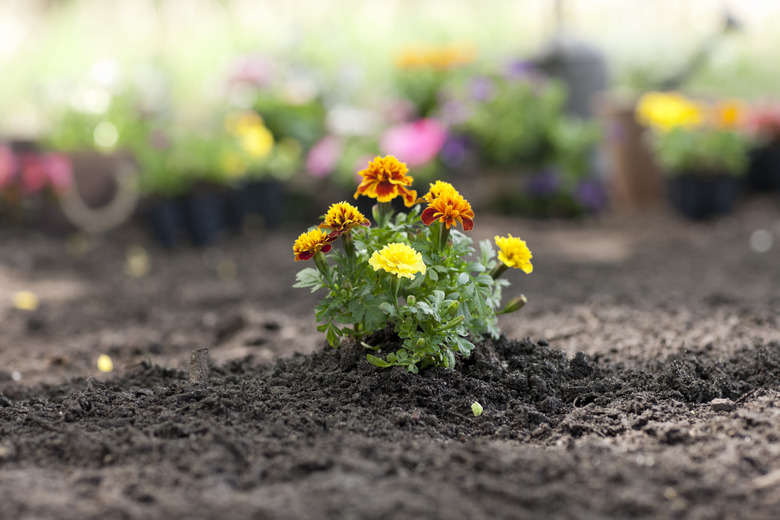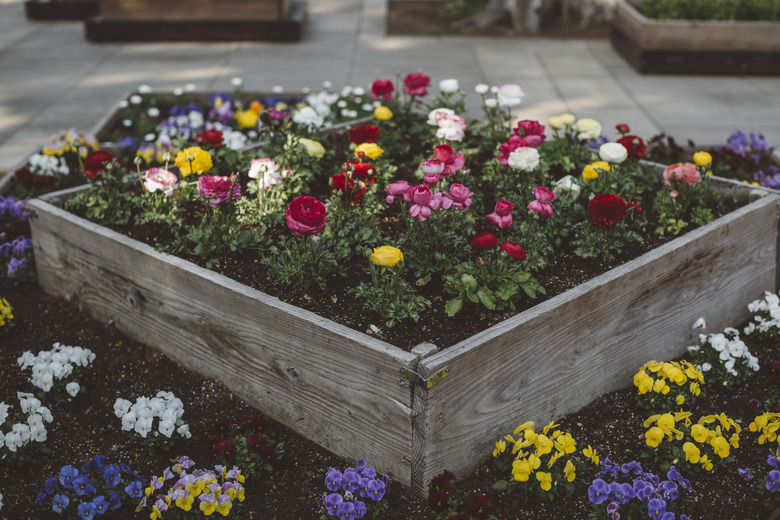Soil Preparation For Flower And Vegetable Gardens
We may receive a commission on purchases made from links.
Soil preparation for a garden involves a bit more than simply loosening the top layer, digging small holes, and filling them with seeds and seedlings. Most garden soil benefits from first mixing in other materials, such as compost, to improve the soil's texture and composition.
Like Goldilocks and her preference for a bed that's neither too hard nor too soft, the average garden plant prefers soil that's neither too hard and claylike nor too soft and sandy. The perfect in-between blend improves the soil's ability to provide nutrients to your plants. A couple of soil tests beforehand help determine what needs to be added to make soil that's just right for your flowerbed or vegetable garden.
Determining Soil Composition
Determining Soil Composition
Soil contains a number of components, such as sand, clay, and silt. All of these affect the growing conditions for plants in terms of the availability of nutrients and moisture in the soil. Clay soil holds too much water, which could cause root rot, while overly sandy soil doesn't hold water or nutrients well.
A quick way to figure out the basic type of soil found in your garden bed is to dig out a handful while the ground is moist but not soaking wet. Squeeze the soil into a ball. If it keeps a firm ball shape, the soil contains a lot of clay. If it crumbles in small, loose clumps, it has good composition; if it runs through your fingers like sand, the soil has a lot of silt or sand.
A more elaborate way to determine the approximate percentages of sand, silt, and clay in the soil is nearly as easy. Fill a small, glass jar two-thirds full with water and then add garden soil until the jar has just a little space on top. An optional pinch of powdered laundry detergent helps separate the particles. Place the lid on the jar, shake it vigorously, and then set it aside for a couple days to settle. The settled bottom layer is sand topped by silt and then clay.
Measure the depth of each solid layer and then average it as a percentage of the total solids. For instance, if they're equal, the soil contains approximately 33 percent each of sand, silt, and clay. Compare the percentages on a soil textural triangle chart, available on some county extension websites, to determine the soil's overall composition. Knowing the composition helps determine what kinds of amendments will improve the soil, especially if it contains mostly clay or mostly sand. In most cases, knowing the exact makeup isn't necessary, but having a general idea, even by visualizing the results of your jar test, lets you know what kind of amendments will improve the garden soil.
Testing Soil for Lead
Testing Soil for Lead
If you plan on planting vegetables, herbs, or anything edible, a lead test for the soil is important beforehand, as lead may get into the food, making it less safe for consumption. Lead issues are most likely in urban and suburban areas, plots that are near roadways, and plots close to older homes that may have been painted with a lead-based paint at some point or that once had lead pipes. Sites in industrial regions are also at risk. Soil often contains low levels of lead naturally, but high levels, such as 400 parts per million or greater, put people at risk, as lead can cause behavioral issues and learning disabilities in children as well as other serious health concerns.
If the garden is only for flowers, shrubs, and the like, a lead test is not necessary, but you may wish to have the test done anyway if children play in the area. Contact your nearest cooperative extension service to find out if they perform soil lead tests or if they can recommend nearby labs that do. In many cases, the lab sends a kit or offers information on how to collect the samples properly and where to send them. If the soil test results come back showing moderate to high lead levels, a raised bed or container garden using completely new, fresh soil is a much better and safer option than planting in the contaminated soil.
Testing Soil pH Range
Testing Soil pH Range
The soil pH range also helps determine how your plants might do in their growing environment. The best pH range for one plant varies from the next, but many garden plants prefer a fairly neutral or slightly acidic pH in the 6.0 to 7.0 range, with 7.0 being neutral. A soil pH test helps determine whether the soil is acidic, which means a low pH, or alkaline, which means a pH higher than 7.0.
While you could send soil samples to a lab or use a pH meter to determine very specific pH levels, the more general DIY approach is much more fun and involves a common garden staple: red cabbage. Bring 2 cups of distilled water, not tap water, to a boil; distilled is necessary because it has a neutral pH. Simmer five red cabbage leaves torn into several pieces for 10 minutes and then let the pot sit for 30 minutes or so. Strain out the cabbage while pouring some of the liquid into two different clear glass containers. One container is purely for reference.
Add 1 to 2 tablespoons of soil to one container and then wait 30 minutes or so. If the liquid turns greenish or yellowish, the soil is alkaline; if it turns red, it's acidic. The more intense the color change compared to the liquid-only jar, the more alkaline or acidic the soil. If the color doesn't change at all, the soil has a neutral pH. This DIY approach only gives a general pH assessment and not the specific pH measurement that comes from sending multiple soil samples to a lab through the county extension office.
How To Amend Garden Soil
How To Amend Garden Soil
The general composition and acidity levels of the soil are your starting points to determine the best amendments for soil preparation and improvements to the soil. Amend virtually any type of soil by adding a couple inches of well-aged compost and then rototill it into the soil at least 6 inches deep. This is best done in late fall through winter to give the nutrients time to mix into the soil, but it's not a deal breaker if you wait until spring.
If you don't have a rototiller, loosen the soil with a shovel to a depth of 6 or more inches and then turn the compost into the soil with the shovel so it mixes with the soil thoroughly. Aged compost has a fairly neutral pH, so this helps bring overly acidic and overly alkaline soils closer to a neutral pH while also providing nutrients.
For clay-heavy soil, add compost or other organic matter to make the soil easier to dig, to improve drainage, and to improve nutrient content. Organic matter also benefits sandy soil, which doesn't retain moisture or nutrients well. Mix 3 inches of well-aged compost or sphagnum moss into the soil about 6 inches deep. Adding small amounts of peat moss or fallen leaves over time also helps. Wood mulch or wood chips added after planting help the soil retain moisture and nutrients. Adding about 1 inch of well-aged compost to virtually any soil type each year, such as at the end of the growing season, helps keep the soil healthy. Healthy soil also attracts earthworms and microbial life that further improve the soil conditions. If you see earthworms in the soil, it's fairly healthy soil.
Adjusting Soil pH
Adjusting Soil pH
Depending on what you plan to grow, you may need to change the soil pH a bit. If the soil is too acidic for your chosen plants, add dolomitic limestone in fall and mix it into the soil, at the rate recommended by soil-test results. If the soil has a lot of sand content, you may need to add about 4 pounds of powdered limestone per 100 square feet using a spreader and then mix the soil with a tiller or shovel. For clay-heavy soil, you may need as much as 8 pounds of limestone per 100 square feet.
To make soil more acidic and lower the pH level, add elemental sulfur at the rate recommended by soil-test results. You may need, for example, up to 2 pounds per 100 square feet for clay soil. Mix it in by tilling or using a shovel. Amending in the fall is best, as it gives the soil time to adjust.

